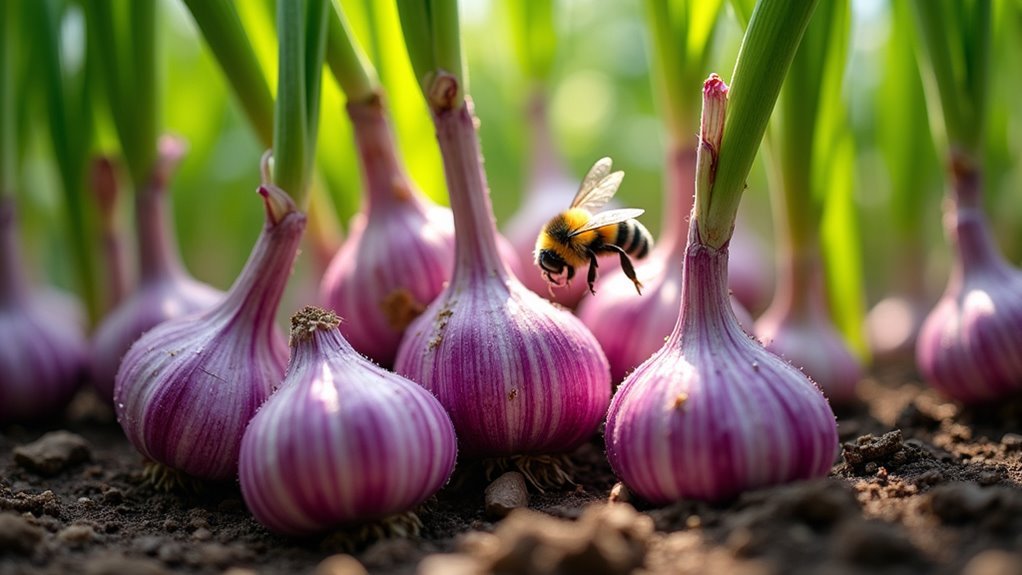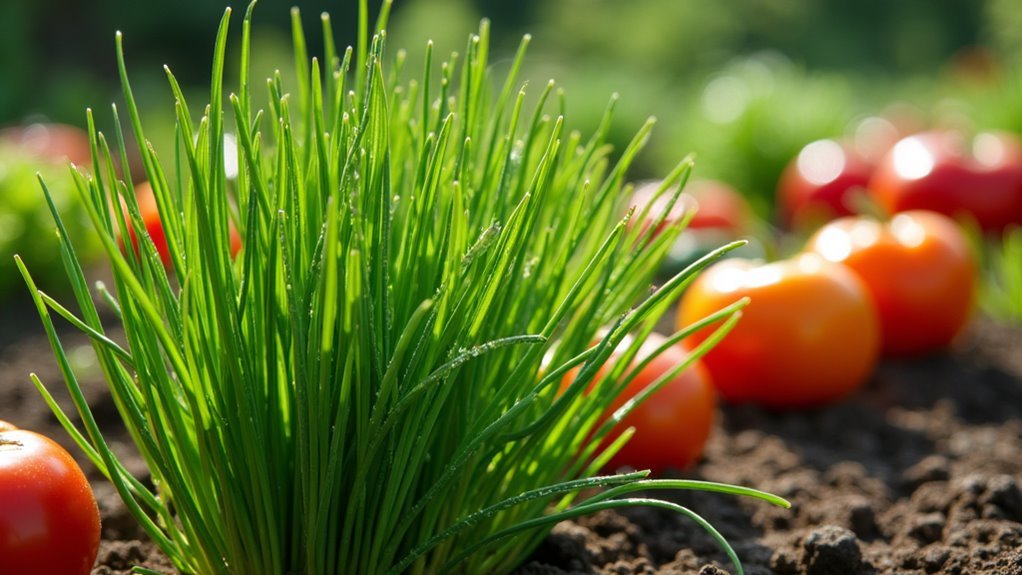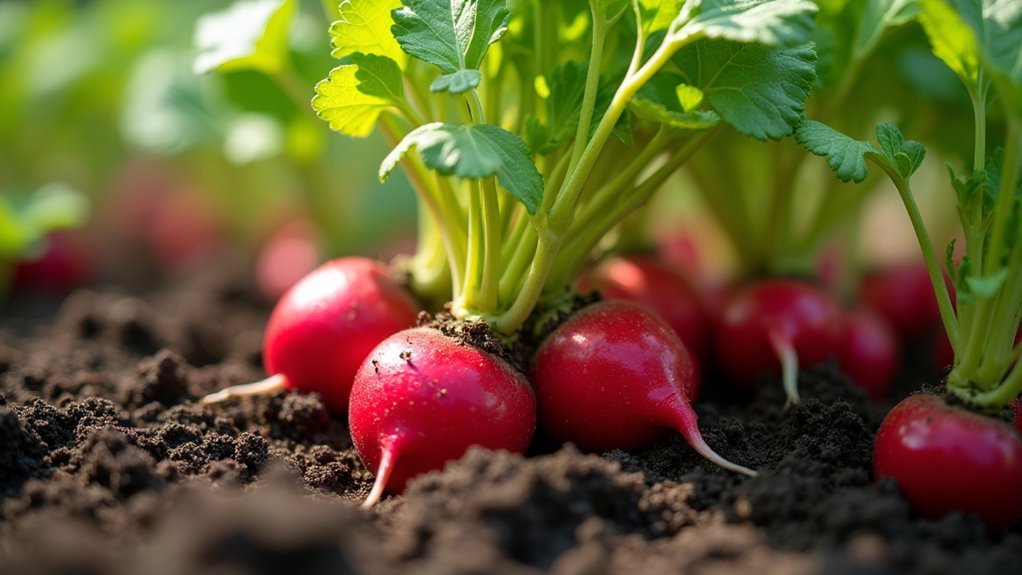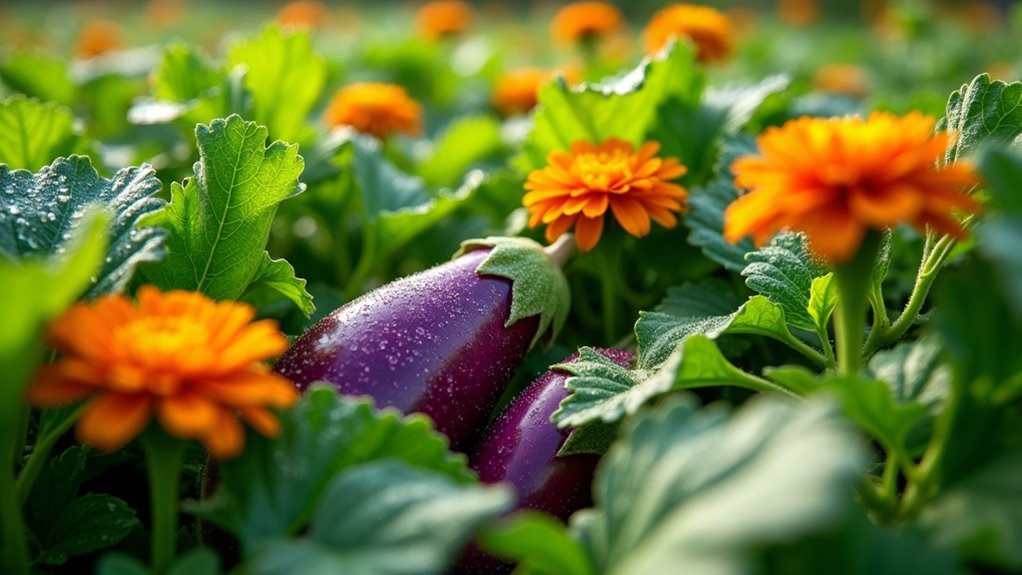You can naturally protect your garden by planting garlic, onions, and chives, which release sulfur compounds that repel aphids, cabbage worms, and Japanese beetles. Radishes work as both pest deterrents and trap crops, drawing cucumber beetles away from valuable vegetables. The cabbage family also serves as effective decoy plants for moths and other destructive insects. Strategic companion planting with these protective vegetables creates multiple layers of defense that’ll transform your garden into a pest-resistant ecosystem.
Garlic: A Powerful Allium Against Garden Invaders

Garlic stands as one of nature’s most effective pest deterrents, releasing powerful sulfur compounds that send garden invaders fleeing. When you crush garlic cloves, these compounds actively repel bugs like aphids, cabbage worms, and slugs from your garden beds.
You’ll find garlic easy to grow in various soil types, thriving best in well-drained soil with full sun exposure. As a companion plant, it enhances nearby crops’ health while providing natural pest control that eliminates your reliance on harmful chemicals.
This dual-purpose culinary herb doesn’t just keep pests away – it adds incredible flavor to your kitchen creations.
Onions: Natural Sulfur Compounds That Deter Pests
Onions pack a serious punch against garden pests through their natural sulfur compounds, which create an invisible shield around your vulnerable crops.
When you crush or damage onion plants, they release these potent compounds that effectively repel pests like aphids and cabbage loopers. The strong odor acts as a natural deterrent, making onions an excellent companion plant alongside carrots and lettuce.
Here’s why you’ll love growing onions for pest control:
- Versatile growing conditions – thrive in various climates and soil types
- Long-term pest reduction – incorporate into crop rotations for healthier ecosystems
- Multi-purpose benefits – harvest nutritious vegetables while protecting other plants
- Effective against multiple pests – deter carrot flies, aphids, and cabbage loopers
You’ll enjoy both pest protection and fresh onions for your kitchen.
Chives: Multi-Purpose Protection for Vegetable Gardens

You’ll find chives offer exceptional pest control benefits through their strong onion-like scent, which naturally repels Japanese beetles, carrot flies, aphids, and mites from your vegetable garden.
These hardy perennial herbs work perfectly as companion plants when you place them near carrots, tomatoes, and other vegetables that commonly suffer from pest damage.
They’re incredibly easy to grow in most garden conditions and require minimal maintenance while providing continuous protection throughout the growing season.
Natural Pest Deterrent Properties
Among the most versatile alliums for natural pest control, chives offer gardeners a powerful defense against multiple garden threats while serving double duty as a culinary herb.
These plants naturally repel harmful insects through their strong scent, making them excellent companion plants for your vegetable garden.
Chives deliver extensive natural pest control by targeting several problematic species:
- Japanese beetles – deterred by the pungent aroma
- Carrot flies – confused by the intense allium fragrance
- Aphids – repelled by sulfur compounds in the leaves
- Spider mites – discouraged from settling on nearby plants
You’ll find chives don’t just keep pests away – they also attract beneficial insects like bees for pollination.
This dual action creates a balanced garden ecosystem where unwanted visitors stay out while helpful pollinators thrive.
Compatible Companion Plant Combinations
When planning your companion planting strategy, chives form exceptional partnerships with numerous vegetables that benefit from their protective qualities. These hardy perennials are compatible with vegetables throughout your garden, solving pest problems while promoting healthy plants.
| Vegetable | Pest Deterred | Garden Benefit |
|---|---|---|
| Carrots | Carrot flies | Enhanced growth |
| Tomatoes | Aphids | Stronger flavor |
| Peppers | Japanese beetles | Improved yield |
Chives repel aphids and other destructive insects through their potent onion-like scent, which masks the attractive aromas of vulnerable crops. This companion planting approach creates a natural defense system that protects multiple vegetables simultaneously. You’ll maintain these benefits by harvesting chives regularly, ensuring continuous pest protection while enjoying fresh herbs for your kitchen.
Growing and Placement Tips
Since chives adapt to various growing conditions, you can establish them virtually anywhere in your garden where they’ll receive at least six hours of direct sunlight daily.
These versatile plants thrive in well-drained soil and tolerate USDA zones 3-9, making placement flexible for most gardeners.
Strategic placement tips maximize their pest-repelling potential:
- Plant near vulnerable crops – Position chives alongside carrots, tomatoes, and other susceptible vegetables to repel Japanese beetles, carrot flies, and aphids.
- Create border plantings – Use chives as natural barriers around garden beds to deter pests from entering.
- Container growing – Place potted chives throughout your garden for mobile pest protection.
- Harvest regularly – Cut stems frequently to encourage bushier growth and stronger pest-repelling compounds.
Proper growing techniques guarantee your chives effectively protect surrounding plants while providing fresh herbs for cooking.
Radishes: Underground Defenders Against Soil Pests

Radishes serve as powerful allies beneath the soil surface, actively repelling troublesome pests like cabbage maggots, cucumber beetles, and carrot rust flies. You can strategically plant radishes as a trap crop to draw insects away from valuable vegetables like carrots and cucumbers. This clever technique helps keep pests away from your prized plants while radishes repel soil pests naturally.
You’ll find radishes thrive in full sun or light shade with well-drained, rich soil. Their fast-growing nature means you can harvest them within weeks, quickly establishing effective pest control.
Plant them densely around vulnerable crops to minimize pest damage. By incorporating radishes into your garden layout, you’ll reduce harmful insect populations while enhancing overall biodiversity and neighboring plant health.
Cabbage Family Vegetables as Trap Crops
You can turn cabbage family vegetables like broccoli, cauliflower, and cabbage into strategic sacrificial plants that lure pests away from your prized tomatoes and peppers.
These trap crops work by attracting specific pests like aphids and cabbage moths through their natural scent and appearance, fundamentally acting as decoys in your garden defense system.
When positioned correctly around your valuable crops, they’ll draw harmful insects to themselves while your main harvest plants grow undisturbed.
Sacrificial Cabbage Plant Strategy
While most gardeners focus on repelling pests, the sacrificial cabbage plant strategy takes a different approach by deliberately attracting them to specific plants. This pest management technique uses sacrificial cabbage plants as trap crops, drawing cabbage moths and aphids away from your valuable vegetables.
You’ll plant these decoy crops around your garden’s perimeter or scatter them between your main vegetables. The appealing scent and foliage of cabbage family plants naturally lure pests away from crops you want to protect.
Here’s how to implement this strategy effectively:
- Plant cabbage, kale, or broccoli as dedicated trap crops
- Monitor these sacrificial plants regularly for pest activity
- Remove infested crops promptly to prevent spread
- Replace removed plants to maintain continuous protection
This approach can greatly reduce damage to your primary harvest.
Pest Attraction Mechanisms
Understanding the science behind why cabbage family plants work so effectively as trap crops reveals the sophisticated chemical warfare happening in your garden.
These vegetables release specific glucosinolates and volatile compounds that create irresistible chemical signals for target pests. Broccoli and cauliflower’s pungent scents don’t deter pests—they actually draw insects away from your valuable crops by mimicking ideal breeding and feeding sites.
The compounds attract aphids, cabbage moths, and flea beetles through chemical communication that overrides their normal dispersal patterns.
Companion Crop Protection
Since these chemical attractants naturally concentrate pest populations, you can harness this biological response by strategically positioning cabbage family vegetables as protective barriers around your main crops.
These plants effectively keep pests like cabbage worms, aphids, and flea beetles away from your valuable tomatoes and peppers.
Implementing trap crops protects your garden through several key strategies:
- Strategic placement – Plant broccoli, cauliflower, or cabbage in rows around your main vegetable garden
- Pest diversion – Draw harmful insects away from primary crops before they can cause damage
- Population control – Monitor infested trap crops and remove them to reduce overall pest numbers
- Barrier creation – Form protective clusters that intercept pests before they reach target plants
Regular monitoring guarantees you’ll catch infestations early and maintain effective protection.
Companion Planting Strategies With Pest-Repelling Vegetables
Although many gardeners focus on individual pest-repelling vegetables, you’ll achieve far better results by strategically pairing these natural defenders with vulnerable crops throughout your garden.
Use companion planting to create protective barriers where pest-repelling plants keep bugs away from susceptible varieties. Plant basil alongside tomatoes and peppers to help repel thrips and fruit flies while enhancing flavor.
Position garlic and onions near carrots and lettuce to deter aphids and carrot flies. Chives work excellently with tomatoes to ward off Japanese beetles.
Place radishes beside cucumbers to trap cucumber beetles before they damage your main crop. Mint acts as a natural insecticide against ants and mosquitoes but contain it in pots to keep your garden from being overrun by its aggressive spreading.
Maximizing Vegetable Garden Protection Through Strategic Placement
When you position pest-repelling vegetables throughout your garden with strategic intention, you’ll create multiple layers of protection that work together to shield your crops from damaging insects.
To keep bugs at bay and maximize your garden’s natural defenses, focus on these placement strategies:
Strategic placement of pest-repelling vegetables creates natural defenses that work together to protect your entire garden from harmful insects.
- Create protective borders – Ring vulnerable plants with garlic, onions, and marigolds to repel aphids and other common pests.
- Establish intercropping patterns – Alternate rows of susceptible vegetables with chives and radishes to deter beetles and flies.
- Build natural barriers – Position strong-scented plants like garlic near brassicas to form protective zones against cabbage worms.
- Design companion clusters – Group complementary vegetables together so each plants’ repelling properties reinforce the others.
This systematic approach transforms your entire garden into an integrated pest management system.
Growing and Maintaining Your Natural Pest Control Vegetable Arsenal
Once you’ve planned your strategic placement, the success of your natural pest control system depends entirely on how well you grow and maintain these protective vegetables.
Regular watering schedules guarantee garlic and chives develop strong sulfur compounds that effectively repel pests. You’ll need to prune chives consistently to maintain their beetle-deterring properties while encouraging new growth.
Radishes require quick succession planting every few weeks to maintain their natural barrier against cabbage maggots throughout the growing season. Proper soil drainage prevents root rot in garlic bulbs, maximizing their pest management potential.
Monitor these pest-repelling vegetables weekly for signs of stress or disease. When you maintain ideal growing conditions through consistent care, your vegetable arsenal delivers maximum protection against garden pests.
Frequently Asked Questions
What Do You Plant With Vegetables to Keep Bugs Away?
You’ll want to plant garlic, onions, and chives near your vegetables to repel aphids, cabbage worms, and carrot flies. Add nasturtiums as trap crops and grow mint in containers to deter mosquitoes.
How Do I Keep My Vegetable Garden Pest Free?
You’ll keep your vegetable garden pest-free by companion planting garlic, chives, and onions alongside your crops. These natural repellents deter insects with their strong scents while herbs like basil create protective barriers.
What Is the Best Homemade Pesticide for Vegetable Gardens?
You’ll find soap spray most effective for vegetable gardens. Mix one tablespoon liquid soap with one quart water to suffocate aphids and spider mites without harming your plants or beneficial insects.
What Plant Works as a Natural Pest Control?
You’ll find garlic works exceptionally well as natural pest control. It releases sulfur compounds that effectively repel aphids, cabbage worms, and various other garden pests, making it a powerful deterrent.
What Plant Keeps Pests Out of the Garden?
You’ll find garlic works exceptionally well at keeping pests away from your garden. It releases sulfur compounds that repel aphids and cabbage worms, making it one of nature’s most effective pest deterrents.
In Summary
You’ll transform your garden into a natural fortress by strategically planting these pest-repelling vegetables. Don’t underestimate garlic’s power against aphids or radishes’ ability to deter root maggots. You’re creating an ecosystem where plants protect each other while providing you with fresh produce. Start small with companion planting, then expand your natural defense system. You’ll reduce chemical pesticide dependence while maintaining a thriving, productive garden that works with nature’s own protective mechanisms.





Leave a Reply